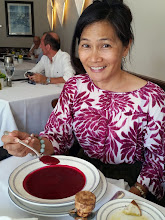What is it about Porto’s that makes the name a magic word in households throughout Southern California? Is
it the efficient elegance of their spacious stores? The baked goods and café
offerings, which despite their exotic origins, are made up of ingredients that are
easily accessible even to the most finicky or jaded of palates?
 |
| Forget Tiffany's window: The cases at Porto's hold jewels of the pastry chef's art. |
Porto's is one of those places in my orbit that deserves the
GMS Award for Truly Drawing the World Together. The Cuban bakery-cafe attracts a
microcosm of L.A.’s melting pot (can I still say that?). Women in hijabs, Asians from throughout the
Pacific Rim. A myriad of Chicana/o, Latina/o, and Hispanic folks from around
the world, and everyone else flock to Porto’s to stand in line, waiting to
feast on the legendary potato balls, tres leches cake, or rellenitos – sweet plantains stuffed
with black beans.
 |
| Carbo-loading at Porto's: Chorizo empanada, plaintain rellenito, and the legendary potato ball. |
If you aren’t that hungry when you get to Porto’s, that will
change within seconds of standing in line and gazing at the pastry
cases. Limited access to Porto’s from most parts of L.A. is also part of the
bakery’s mystique. There are only three stores, located in Downey, Burbank, and
Glendale. Even on a Wednesday afternoon, there are long lines of hungry
customers.
The stores’ interiors are all more or less the same: spacious but efficiently furnished with rows of indoor and patio seating. A couple of extra-long glass cases reign over the space, like pastry-bearing Arks of the Covenant. But instead of stone tablets, they are filled with fanciful interpretations of Hispanic and European pastries. Where else can you get coconut strudel and mango mousse? Red velvet cupcakes are topped with rose petals, and mini-pina colada mousse desserts are graced with orchids. Even the humble blueberry muffin gets the Porto's treatment, split in half and filled with cream and fresh berries, taking it from commuter cup sidekick to an elegant dessert.
The stores’ interiors are all more or less the same: spacious but efficiently furnished with rows of indoor and patio seating. A couple of extra-long glass cases reign over the space, like pastry-bearing Arks of the Covenant. But instead of stone tablets, they are filled with fanciful interpretations of Hispanic and European pastries. Where else can you get coconut strudel and mango mousse? Red velvet cupcakes are topped with rose petals, and mini-pina colada mousse desserts are graced with orchids. Even the humble blueberry muffin gets the Porto's treatment, split in half and filled with cream and fresh berries, taking it from commuter cup sidekick to an elegant dessert.
The airy interiors, with their immaculate tiled floors make
you feel like you are in Batista’s Presidential Palace. The
enervating rhythm of salsa keeps the staff and customers moving along at
a steady pace. Angelenos, who are not known for their patience in most
situations, seem to think nothing of standing in a line of 75+ people for cranberry
walnut bread, empanadas, and guava and cream cheese-filled refugiados.
 |
| The ordinary blueberry muffin gets a little Porto’s swagger. |
I have a physical therapy appointment, which my insurance plan, in its institutional lack of intelligence, has decided should take place at a clinic in Downey, miles away from the Westside. But no matter. When life gives you lemons, head for Porto's.
Dinner is hours away, but I can't resist taking a little merienda. Although I want to ask for the whole tray of chorizo empanadas, I attempt restraint and order only one of the piquant pies. And a potato ball – the love child of shepherd's pie and Tater Tots. And a rellenito.
I tuck into my chorizo empanada and rellenito greedily, but it seems strange to be there without a crowd of friends. I feel almost guilty at indulging in such a rare treat by myself. But no worry - you're never really alone at Porto's, because you've got to remember to pick up dulce de leche kisses and pastels de guayaba for everyone at home.









